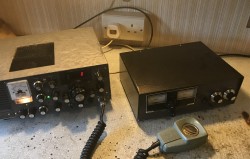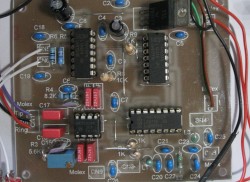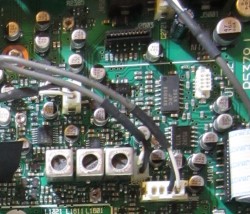Our thanks to Essex Ham member Ed G8FAX for submitting the following article.
The relevance of construction to the radio ham today – a bit of history and going forward
 In bygone days Radio Hams had to make many of their own components. In terms of technical electrical/rf competence, I suggest their knowledge was apt for their time but much less than current requirements. They needed various practical skills, such as wiring, cabinet making and metal bashing, hence they needed access to good workshop facilities and a range of materials to make cat’s whisker detectors and spark gap transmitters.
In bygone days Radio Hams had to make many of their own components. In terms of technical electrical/rf competence, I suggest their knowledge was apt for their time but much less than current requirements. They needed various practical skills, such as wiring, cabinet making and metal bashing, hence they needed access to good workshop facilities and a range of materials to make cat’s whisker detectors and spark gap transmitters.
As the demand for broadcast radio and other commercial wireless services evolved, understanding of electronic technicalities grew as did the demand for ready-made components, these found application in the Amateur Radio community. As technological advances were made and with an increasing number of services springing up there became a need for improvements to address issues like frequency stability and interference. The electronic/rf technical demands on Hams therefore increased. With mass production looming the requirement on fabrication and assembly lessened somewhat, but good practical skills were still essential in addition to sound technical knowledge.
 The Second World War saw the mass production of good quality valved radio equipment, which sometime after the war was over found its way to Radio Hams. It could be used directly or with slight modification and of course keeping it good working order and making occasional repairs still necessitated good technical skills and some practical ability on the electronic/rf front.
The Second World War saw the mass production of good quality valved radio equipment, which sometime after the war was over found its way to Radio Hams. It could be used directly or with slight modification and of course keeping it good working order and making occasional repairs still necessitated good technical skills and some practical ability on the electronic/rf front.
The widespread use of transistor technology and also that of PCB fabrication saw the start of miniaturisation and company’s, especially in Japan mass producing equipment specifically for Radio Hams. This had two main effects, Hams could buy and use equipment straight out of the box and didn’t need to modify other apparatus or build their own. Plus it made Amateur Radio more accessible. Yes the cost was high, however considering the extra theoretical knowledge acquisition (books, courses etc) and the need for good and expanded workshop facilities and skills (PCB design and manufacture), there was a general decline in construction.
 Further advances in electronics have led to greater reduction of component size (surface mount technology), very large scale integration (complex integrated circuits), which push the bounds of homebrew construction for the vast majority of us. The drive for mass production in the Far East, China, for example, has seen a great number of very cheap rf and other useful electronic modules appear on outlets like Ebay that has changed how home construction and building occurs, it now principally by buying and connecting together a number of modules or blocks.
Further advances in electronics have led to greater reduction of component size (surface mount technology), very large scale integration (complex integrated circuits), which push the bounds of homebrew construction for the vast majority of us. The drive for mass production in the Far East, China, for example, has seen a great number of very cheap rf and other useful electronic modules appear on outlets like Ebay that has changed how home construction and building occurs, it now principally by buying and connecting together a number of modules or blocks.
A further big game changer is the advancement of digital technology in communications and electronics in general, as well as a shift to computers and software. This places greater demands for theoretical and practical skills for those wanting to do home construction. In some respects, it considerably lessens the need for extensive workshop facilities and tools as with an SDR block just software needs to be created on a computer. With the many free programs available to develop SDR applications, there is no additional expense needed above the SDR hardware, assuming one already has a computer to connect it to.
Thus I see traditional radio construction is rapidly dying. For some time, in IT parlance, “building a computer” is taken to mean installing one or more software packages on a machine and configuring it. Even putting together the various parts to make a desktop PC is on its way out. These ideas of ‘building’ are different to my experience of soldering together a (considerable) number of ’74-logic’ IC’s to make a computer. Thus construction of radios in the future will be along similar lines, it will all be software and programming.
I doubt that this change in construction will kill Amateur Radio, it most certainly alters how things are made and for sure Hams wanting to engage in radio construction and experimentation will need to gain new theoretical knowledge and develop vastly different practical skills. These are exciting times and will take the hobby to a new level.
Ed G8FAX
Thanks Ed. Any comments? Please add them below


As somebody who’s job role has fallen victim to the fact that computers are so much less physically or economically reparable than they were, it is a shame to say that in some ways it is true what you say. Even my TV is an android device (so essentially a single board computer). The fact I actually enjoy construction also means it would be a shame if amateur radio did not provide the opportunity for me to ‘play’. I would not have taken my licence if there was no electronics involved in amateur radio. That said, I do like computers, I am studying IT again (already have A level, soon to be a degree) so the point computers and radio cross is of tremendous interest, and programming is still ‘technical’ in my mind. When I have some spare cash, I do want to see what I can do with a Raspberry pi and Arduino. And what a fantastic time to be a new radio amateur, £25 for a radio and I can get the local reapers 5miles away, add a slim Jim and I can get 20miles from an upstairs bedroom. For construction to no longer be any part of amateur radio would destroy it for me, but I am also happy to take advantage of the low cost, mass produced equipment. I guess that is the beauty of such a multifaceted hobby, you can take the bits that interest you, but it is obviously important all aspects have enough of a following as otherwise some areas will vanish as mentioned.
There will always be enthusiasts, I have seen some wonderful very well made replicas of early pioneering radios. I’m sure that will continue in the future. Various components will become obsolete and any remaining stock will command very high prices, it is and has been big business comerically for years trading in obsolete or obsolecent components. For the average Ham the cost will be too much and hence construction by far and large will die out and be replaced by computers, software and programming. It is already happening.
My first experience of constructing anything electrical would have been possibly late 80s, more likely early to mid 90s, from Maplin kits and the such like. I guess I don’t really have an appreciation of how construction used to be and how much it has already changed.
You should get along to an open day at Sandford Mill when they have one https://www.chelmsford.gov.uk/museums/visit/sandford-mill/
A good historical summary Ed. While the very small modern components do present a challenge for the home constructor it is not essential to use them. Larger, older generations of components are still available, and despite what the Japanese advertising might lead you to believe, analogue radios do still work :-) and simple designs suitable for home construction by beginners will still communicate with the latest SDR radios !
While getting started can seem daunting to beginners, there are things than can e done to help them. The Colchester club ran a very successful “club build night” of G4HUP’s RF current meter kit which went very well. There is still a reasonable selection of kits available from several suppliers. Of course simple designs tend to be for CW transceivers, but then that’s just another challenge to tackle.
I agree with what you say Peter. My point is that over the years, the way in which we construct things has changed, we (in the main) no longer use valves for example. It is also changing and declining in the rise of the digital age with software and programming. At some point in the future the main way of construction will be by software engineering using software like GNUradio, to make a receiver or transmitter.
As an example of how construction is changing in Amateur Radio, over Xmas break I put together 3 radio systems, one for ADS-B, another for AIS and the third for data modes (JT65, FT8 etc). My soldering iron never saw light of day, all was completed using IT techniques in software. The data mode decoder was connected not by a physical patch cable but by another bit of software called a ‘virtual audio cable’. It was a matter of downloading (for free), installing and configuring the component modules to work together. It was not particularly difficult and cost nothing extra above my cheap RTL dongle (bought for £5.00 new on Ebay) and my Windows based laptop, that I have for other purposes anyway. I was going on to make a system along simialr lines for the low orbit NOAA weather satellite maps, I had to draw line under this as although I could hear weak signals, these were obliterated by a very nearby commercial high power transmitter regularly keying up. By the way, all of these I got going on my homebrew loft-mounted 2m colinear made from a length of twain & earth mains cable and some RG58. The cost of making radios in the digital era does not need to be expensive, but a different skill set is needed.
With a fixed installation and interferer, you could have knocked up an active cancellation system. We used to get >60 dB isolation, I assume that would be enough ;0)
I didn’t attempt to quantify anything, it was more just a test to see if it would work. Sat sig was just above noise floor and interfering sig was well saturating the other end stop as shown in SDR#. When I identified the offending service, it was due to be ceased by now, so decided to leave things. Have not checked yet to see if the service has been stopped and if another has sprung up on the same freq. Life and other projects have entered in to the mix.
These days it is only worth constructing equipment that you cannot buy (either because of cost or because it does not exist). Even the industry itself is going to ever higher levels of abstraction so
there is no shame in using these new system level components.
If you do design something do it using free PCB/Schematic tools and share your design with others.
PCB manufacture is really cheap now and it is getting to the stage where automated assembly is
becoming affordable. As no one can be an expert in everything what we should be doing is becoming
more like maker spaces, sharing skills. facilities etc with each other. While I am happy writing code
for FPGAs, GPUs etc there are times when I need a box milled for example and for that I have to rely
on others. So embrace the changes, we can do far more than we ever could before.
As they say “you ain’t seen nothing yet”.
Yep.
A few people I know that own or have acces to a 3D printer are designing and printing their own custom enclosure.
Others owning or having access to suitable laser cutter are designing their own pannels for kit.
Maker spaces are a great resource if you are lucky to have one near at hand. I travel up to the Ipswich Maker Space mostly to use their laser cutter, but also to meet with others interested in technology and building things.
But I don’t quite agree with “These days it is only worth constructing equipment that you cannot buy”. There has always been great educational value to be had from a bit of “wheel reinvention” :-)
That was just my personal view, maybe I should have said it is not worth me constructing stuff I can already buy, mainly because I am starting to get on a bit now and time is precious.
What I wanted to say is that construction as we knew it is changing, when one door closes another one opens. I believe home construction is not dead it has just moved to the next level and we should too.
“Re-inventing the wheel”, may be better known in schools colleges, universities etc as “laboratory experiements” as is of great value educationally.
“maker spaces” are wondeful. I wish there was one more local to me & I must venture up to Ipswhich or Cambridge one, one day.
On a similar theme, to Maker spaces, there is something else springing up called “Men’s Shed” ( I might have named it something different this day and age). I found out there is one within a mile from me and another in the process of being set-up Southend way.It appears to be a National thing, so might be worthwhile checking these out in your area. I have yet to visit, apparently it has some metal working facilities and a lathe.
There is also a number “Fab Labs” around and these might be worth checking out. I understand that these have a range of 3D-printers and laser cutters as well as other, em-em more moden high-tech kit about. A couple of years ago one was trying to be set up in Basildon, al has gone quiet with this.
I am involved with a group of Amateurs that design Amateur TV equipment. 3 of the group are in the U.S and I am in the U.K. We have a project manager, a hardware engineer, a PCB layout designer and myself the software/HDL guy. We regularly have Skype conferences to iron out design issues. The hardware guy has a PCB assembly and a PCB assembly plant within walking distance. The only real issue we have faced is transporting hardware prototypes between us (because of customs). This would not have been possible even a few years ago. It works very well, after all we are supposed to be an international hobby. I think I have gained far more satisfaction from this than I have from anything else I have done in the hobby. It was TAPR that acted as the dating agency and brought us together. We operate as a non profit so we are not trying to make money and we attempt projects that we think will benefit others.
It’s great that Amateurs are still at the forefront of development and use of these new technologies, and it has always been that way. But lets not forget that the older, simpler. easier to get into, easier to build technologies are still available and still work. I sometimes worry that showcasing all the “new and shiny tech” stuff can be a be daunting to the new comers. There is a different excitement to be had from using something simple and home made to have a QSO, even if it is only to a friend over the other side of town.
Early experiences that hooked me were all with humble 1W transistor transmitters for HF/VHF – BLY33 and BFY51 – and J310 VFOs. What I didn’t know about AM wasn’t worth knowing – but of course, now completely useless… The 40m pico devices from China are today’s short cuts. http://qrpme.com/?p=product&id=RM4